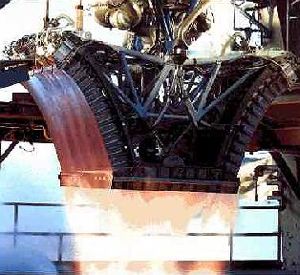
Home - Search - Browse - Alphabetic Index: 0- 1- 2- 3- 4- 5- 6- 7- 8- 9
A- B- C- D- E- F- G- H- I- J- K- L- M- N- O- P- Q- R- S- T- U- V- W- X- Y- Z
RS-2200
 RS-2200 engine test Credit: Boeing |
Status: Development cancelled 1999. Date: 1998. Thrust: 2,201.00 kN (494,804 lbf). Specific impulse: 455 s. Specific impulse sea level: 347 s. Height: 4.32 m (14.17 ft). Diameter: 6.40 m (20.90 ft).
The RS-2200 Linear Aerospike Engine is being developed for use on the Lockheed Martin Skunk Works' Reusable Launch Vehicle, the production follow-on to the X-33. The Aerospike allows the smallest, lowest cost RLV to be developed because the engine fills the base, reducing base drag, and is integral to the vehicle, reducing installed weight when compared to a bell-shaped engine. The. Aerospike is the same as bell shaped rocket engines except that its nozzle is open to the atmosphere. The open plume compensates for decreasing atmospheric pressure as the vehicle ascends, keeping the engine's performance very high along the entire trajectory. This altitude compensating feature allows a simple, low-risk gas generator cycle to be. used. Over $500 million were invested in Aerospike engines up to the contract award date of the X-33, and full size linear engines have accumulated 73 tests and over 4,000 seconds of operation. Throttling, Percent Thrust: 20-109. Dimensions: Forward End: 6.4 m wide X 2.36 m long. Aft End: 2.36 m wide X 2.36 m long. Length: 4.32 m. Designed for booster applications. Gas generator, pump-fed.
Thrust (sl): 1,917.200 kN (431,004 lbf). Thrust (sl): 195,500 kgf. Chamber Pressure: 153.00 bar. Area Ratio: 173. Oxidizer to Fuel Ratio: 6.
| XRS-2200 Rocketdyne LOx/LH2 rocket engine. Development ended 1999. Linear aerospike engine for X-33 SSTO technology demonstrator. Based on J-2S engine developed for improved Saturn launch vehicles in the 1960's. |
Country: USA. Launch Vehicles: X-33, Venturestar. Propellants: Lox/LH2. Agency: Rocketdyne.
Back to top of page
Home - Search - Browse - Alphabetic Index: 0- 1- 2- 3- 4- 5- 6- 7- 8- 9
A- B- C- D- E- F- G- H- I- J- K- L- M- N- O- P- Q- R- S- T- U- V- W- X- Y- Z
© 1997-2019 Mark Wade - Contact
© / Conditions for Use